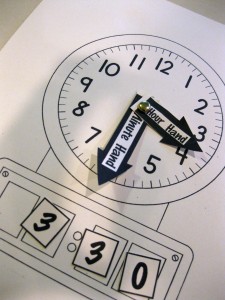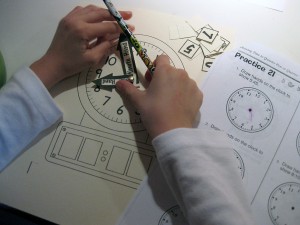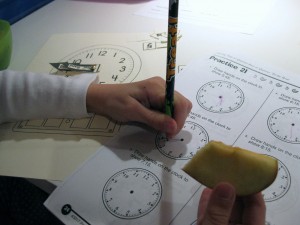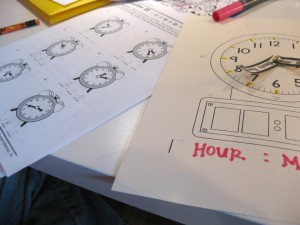 Teaching kids how to tell time is no easy task. But this little analog clock, printed on cardstock–with labeled, movable hands–has made Maddy’s homework this week a whole lot more manageable. (And I’m betting just a little more fun!)
Teaching kids how to tell time is no easy task. But this little analog clock, printed on cardstock–with labeled, movable hands–has made Maddy’s homework this week a whole lot more manageable. (And I’m betting just a little more fun!)
The minute- and hour-hand confusion, the skip counting by 5’s for the numbers on the clock, the craziness of figuring out the hour hand when it’s not really on the hour yet–it all makes for one difficult lesson for many kiddos. And at this point in time, in this digital age where even teaching penmanship is controversial since students do so much work on computers, I have to admit that it takes me a few minutes to think about telling time on an analog clock.
Here are a few resources I used–and hunted down–to get my sweet Maddy over the telling-time hump (or so I hope):
- Teaching Kids How to Tell Time: There’s no magic here, I fear; it’s the ole basic principle of practice, practice, and more practice.
Maddy had several worksheets this week in her homework packet that focused on telling time. She seemed to breeze through the half-hour and hour-clocks from previous weeks, but this week she hit a wall when it came to figuring out the mixed-up hours and minutes.
I knew she needed something in her hands that she could move herself, or she’d be constantly erasing like crazy. Luckily, her amazing first-grade team of teachers provided her with this fab clock a few weeks back. I didn’t realize quite how awesome it was until this week, when the worksheets got a whole new world of tricky.
the clock, before it got its hands
I scanned the Analog Clock and page of numbers, I printed it on cardstock, and we used a gold fastener to secure the hands. I cut two small circles from a margarine lid and placed them on the back of the clock and also between the hands and the clock face; sometimes it helps with spinners and rotating pieces to have more space to move.
The Small Analog Clock with Movable Hands is here to download as a pdf if you’d like. I cannot give credit to anyone other than Maddy’s teachers and school. Many, many thanks yet again!
After the major road bumps Maddy hit the first time she attempted the clock worksheets this week, she seemed a little relieved to have an actual clock to practice on before she drew in the hands on her paper.
When Maddy could actually manipulate the hands, see the numbers better, and see the ‘hour hand’ and ‘minute hand’ written on the pieces, she became more comfortable.
I wrote the numbers by each quarter hour–15, 30, and 45–and that seemed to help her a bit, too.
And really, that’s it–it’s just a clock that helps my sweets with her big-time first grade homework.
And here are a few other time-telling resources I hunted down in a feeble attempt to support this (initially) troubling task:
- Telling Time Lesson Plans: for teching hours, half hours, minutes, etc.
- Telling Time Worksheets: Hours, Create-your-own time (like Maddy’s), analog-to-digital and vice versa, etc.
- Class Clock: Kids can manipulate and change time on the screen
- Telling Time Games!: Even a cute Just In Time board game (love it!)
- A History of Time: Seriously. Sundials and the works.
- Time Concentration Cards (and Set II): LOVE these. Kiddos can match the clock to the correct time.
- Tell the Time Hour Worksheet and Minutes Sheet
- Blank Calendar
- Online Quiz
Math is Fun: Analog and Digital Clock: Kids can set the times and compare the clocks
And that’s it. Just a few time-telling treats to keep in our back pocket and some really cool online stops worth checking out!




gorgeous! the pea just got a really cool learning wristwatch (i know!!!) for his birthday from our friends in england. they got it at the early learning centre–so wish we had one here. anyway, looks just like your paper one, but the clock face is shaded–the right side says “past” and the the left side says “until”! he loves it!
Dana, that sounds like an awesome gift! I’ll have to do some searching!! Thanks!!
Hey–no ‘time’ like the present to get re-focused! :*)
Hope it helps, and if you run into any other worthwhile resources, please do pass them my way, my friend!
Still abbreviated feeds… 🙁
Shanna–I have to be honest, it will be several days before I will have time to research/ adjust/ modify it if necessary. This is SUCH a busy time of year!
Many thanks for your patience, understanding, and for reading, my friend!
Oh! Okay, thanks! 🙂
Great resources. I always remember making a paper plate clock.
hey! I do, too!! Long live the paper plate clock!! :*)
Many thanks for reading!!
When I taught this age, sometimes remembering which hand was which was tricky. So one day I wrote the word “hour” on the board and exactly under the h in hour I wrote the word “minute” so they could see that one word was shorter/longer than the other. I said, “The word ‘hour’ is shorter just like the hour hand. The word ‘minute’ is longer just like the minute hand.” Never again after that did any of my classes get confused. Also, as far as the hour hand not being on a number and instead in between…I always just told my students that if the hour hand hasn’t even gotten to one of the numbers yet, then there’s no way it can be that hour yet, so look at the other number to determine the hour. It helped them so much to know that if the hour hand is between the 7 and 8 that if it hasn’t even touched the 8 yet, it can’t be 8 so they knew to pick 7. Hope this helps someone.
Brandy!! This is SO, so helpful to me–and I’m sure many others, too!!
Many, many, many thanks for taking the time to give us these hints on remembering minute hands/ hour hands and which hour it is. You are totally awesome.
Your welcome! I was hoping I explained it well enough to be helpful. I wouldn’t have left a comment at all except that these two things ALWAYS seemed to help my students more than anything.
You explained it PERFECTLY!!! And I promise to use your techniques asap…and I’m sharing them on http://www.weteachgroup.com, too! :*)
I know that you are in the same school district as I am. And in at our kindergarten parent teacher conference my son’s teacher said she was going to start teaching time soon. Interesting.
I know. I think last year it was the very basics of hours and half hours, and that’s it. This year, they began with a review of those concepts and are adding on–I think they cycle and build on concepts almost yearly, but I could be wrong. Interesting is right.
Visiting from Breastfeeding Moms Unite – what a great post!! Our almost-3-yr-old is fascinated with clocks, both the analog and digital kinds. He is reading the digital numbers from left to right, but he’s not quite sure how to turn three-four into thirty-four. We’ll focus on numbers before we start working on time-telling 😉
Dionna–
Many thanks for writing and stopping by! SO impressed that your 3 yo is interested in time-telling! Kids are so different!
When I taught first grade, my biggest tip for learning time was to wear a wristwatch. Most little kids don’t have them, but it helps a lot. The kids are proud of having their own watch, and they can practice telling time all day long.
Sheila–
Yes. You’re so correct. Maddy needs one, and I think I’ll add it to her birthday or holiday gift list. Thank you!!
The hardest part of learning to use an analog clock for me was how the hour hand is somewhere in between numbers unless it’s x- o’clock. This was back in the late 80’s, so no apps to use, but we all had little paper clocks, just like you show here. And it didn’t help me one bit because the hands don’t move like a real clock, duh. That was so confusing until I actually sat down and played with a REAL clock and could see how the hour and minute hands moved in relation to each other.
For my daughter, who is 4, I bought a cheap clock kit and mounted the hands and numbers on a piece of cork board. Then snapped off the minute hand. She’s learning to tell time to the hour, and there’s only hand to look at for now (I told her when she could count to 60 I would put the minute hand on). I made a bunch of little tags with pictures on them depicting different activities (meals, naps, daddy gets home, therapy, swim lessons, baby’s nap time, etc) and used thumb tacks to stick them around the outside of the clock. But she’s learning what direction the hand moves, what it means when it’s pointing directly at a number, and when the hand is in between numbers.
JESSICA. You win the teaching-time-telling contest, lady. WAY. TO. GO. Thank you for reading, and thank you for the suggestion!!
Great post! Our oldest is extremely bright but was struggling with telling the time. We ended up designing a childrens watch that has some great learne to tell the time features in them. Would love to get your feedback. http://www.sparrowwatches.com